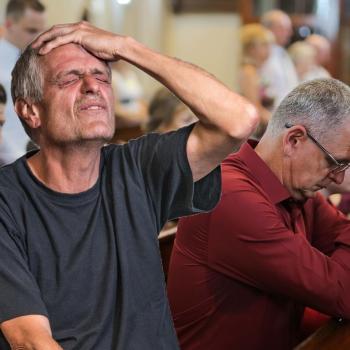In the parish I grew up attending, the priest would sit directly behind the altar during the Scripture readings. His chair was elevated by a couple steps and was centered below the large crucifix mounted on the wall. It almost seemed like he was sitting on a throne to overlook the congregation. In my adolescent view, it kind of felt like people came to Mass to worship the priest. This was one of the many bothersome observations that motivated me to convert to Protestantism as a teenager.
In my church-shopping experiences, most of the churches I’ve attended had more of a stage area for a contemporary worship band. This also allowed enough space for the pastor or speaker to walk freely while sharing a sermon or reflective topic. In just about every Evangelical service I’ve been to, the popular song by Matt Redman was usually played, and quotes,
“I’m coming back to the heart of worship,
And it’s all about You, it’s all about You, Jesus.
I’m sorry, Lord, for the thing I’ve made it
When it’s all about You, it’s all about You, Jesus.”
I’ve heard this song played ad nauseum in my Evangelical years. Depending on who was leading the music or who was speaking, there were times when the services seemed more about watching these people perform on stage and less about actual worship. Years later, I became disillusioned with the vain repetition and wildly subjective styles of contemporary Christian culture that I began to long for something deeper and more reverent. This, among other reasons, led to my eventual return to the Roman Catholic Church.
What’s Missing?
After returning to Catholicism, I felt at home going to Mass regularly at a different parish. I was pleased not to see the priest exalted over the congregation, but something still didn’t seem quite right. It became more evident when I asked my priest why we genuflect towards the altar before sitting in the pew.
“Actually,” he said, “we genuflect before the tabernacle, not the altar.”
For those unfamiliar, the tabernacle is the fancy, golden box where the consecrated host is usually stored. At the basilica I was attending at the time, the tabernacle resided upstage-right in the minor chapel. In my observation, it seemed like most of the parishioners actually faced the altar while taking a knee. I’ve noticed it was usually off to the side in most parishes I’ve attended – even in the church of my youth. In some places, it was even kept in the back of the church!
Once in a while I stumbled across old photographs of how the Mass was done prior to the 1960’s. There was something visually astounding about how the priest faced away from the congregation and towards the altar — surrounded with incense where six candles were lit and the tabernacle towered behind it. I eventually realized this might just be the missing piece! The tabernacle shouldn’t be off to the side, but behind the altar!
Is Church Too Intimidating?
But what warranted such a drastic furniture rearrangement? Many Catholics have argued the Second Vatican Council (Vatican II) had been responsible for such changes. My further exploration of the faith led me to realize there is much disunity within Catholicism, which seems to stem from how the order of the Mass has changed in the wake of Vatican II.
For cathedrals with high attendance, having a sub-chapel specifically for the tabernacle makes sense. I can imagine it being beneficial for places where tourism is quite high, such as Europe. Sight-seers often want to explore the beauty of church architecture while parishioners prefer to pray in peace. But regarding not-so-touristy churches, there doesn’t seem to be any tangible reason other than experimentation with modernist aestheticism. Some could argue the sacredness of Catholic church atmospheres tends to be highly intimidating. This would seemingly justify moving it to the side to enable a more welcoming atmosphere for outsiders.
But if God’s glory is beyond our comprehension, why would He not be intimidating? The Ancient Jews knew they were in the very presence of God when they worshiped the Holy of Holies, and acted accordingly. ¹ It seems as though people have created a false dichotomy that the God of the Old Testament suddenly turned into some apathetic, all-embracing hippy-messiah. If God is apparently the same yesterday, today and tomorrow, then His nature should not have changed even after Jesus’ time on earth. ²
The Heart of Worship
In an Evangelical perspective, going to ‘church’ isn’t necessarily about attending a building per se. The Mystical Body of Christ isn’t something that’s confined within the walls of a structure, but how every individual believer is like an organ within a living organism. ³ The Sunday gathering is when all parts of the Body function in unison. This is one of the reasons why Evangelicals tend to emphasize more on corporate worship and fellowship. Though the social aspect of a church community shouldn’t be the be-all and end-all.
I find it ironic whenever I hear the song The Heart of Worship, and how the artist regrets making the object of worship a thing when the very thing Jesus had given up for us was His Body and Blood. Too often have I heard fellow Christians talk about how Communion had become an idolatrous ritual when it is the very thing that Jesus Himself commanded us to remember Him by during the Last Supper. ‡
In the case of Catholicism, the very heart of worship is Christ Himself in the Eucharist.
It seems as though, unless people truly believe in the Real Presence of Christ in the Eucharist, the placement of the tabernacle couldn’t matter less. It could be placed outside in the parking lot or on top of the roof for that matter. But if the Real Presence is true, then moving the tabernacle does indeed remove Him out of sight. The sacredness of the church building would no longer be present at the forefront where Jesus ought to be the epicentre. I think if we want to authentically reflect our faith through the use of church aesthetics, it needs to be arranged by people who are deeply, theology rooted — not members by name or association, but by faithful, catechized and convicted Catholics.
If Christ is not the heart of our worship, then our church services might as well be a social club on Sundays.
“In accordance with the structure of each church and legitimate local customs, the Most Blessed Sacrament should be reserved in a tabernacle in a part of the church that is truly noble, prominent, readily visible, beautifully decorated, and suitable for prayer.”
— GIRM, The Arrangement of the Church, Paragraph 314 †
REFERENCES:
¹ – Exodus 40
² – Hebrews 13:8
³ – 1 Corinthians 12:12:27
‡ – Matthew 26:17–30, Mark 14:12–26, Luke 22:7–39, John 13:1–17:26
† – Vatican website: http://www.vatican.va/roman_curia/congregations/ccdds/documents/rc_con_ccdds_doc_20030317_ordinamento-messale_en.html#III._THE_ARRANGEMENT_OF_THE_CHURCH












